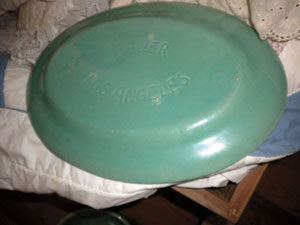
I grew up in a little farming area of Illinois which is now part of the sprawling Chicago metropolis, and our little red brick 2-bedroom house was close enough to Evanston Illinois I made day trips there once I got my driver’s license. I always searched the Chicago Tribune for estate sales in Evanston, and one day saw a sorority house on the campus of Northwestern University advertised a sale. I hopped in my little VW hatchback and went.
I found a huge mess-hall full of Russel Wright dinnerware, his famous “American Modern,” the most popular, sales wise, of any American ceramic dinnerware in history, manufactured in the Midwest in Steubenville, OH from 1939-59. I saw about 100 full place settings of his famous avocado green plates and dishes and serving pieces, along with Russel Wright designed long serving tables and sideboards in blonde maple. I wanted to purchased the whole room, but my little hatchback only fit a few boxes, place settings for about 24.
This experience at 16 started me on a lifelong love of “two coast” Modernism in mid-century ceramics. “Two Coast” because the best of modern ceramics came from either the New York area, blossoming out of the Craftsman tradition, or from around the Los Angeles area. Russel Wright’s firm is still going strong in Burbank, CA, still under the direction, last I heard, of his daughter Annie. 250 million pieces of pottery with Wright’s signature “verso” have been sold.
Now Mrs. V. sends me a piece of mid-century Modern California pottery marked “Bauer Los Angeles.” J. A. Bauer came from Kentucky, whence he potted, moved his family to Lincoln Heights, CA in 1909, and produced some fine garden pots, which I see often enough in some of the old gardens of Montecito. I recently found a set of four huge turquoise pots worth, in the aggregate, about $24,000. Later, in 1930 Bauer Pottery introduced “California Colored Pottery”, the distinctive colors: gold-yellow, orange-red, turquoise-green, and sometimes a sea-cobalt blue, more rarely ringed, in white and black. Somehow, Bauer got the colors just right for the mid-century Modern California casual kitchen, and many of my clients still love the stuff.
Mrs. V’s is a large, 24″ oval platter, no “losses,” which means no hairline cracks or chips. I am often asked how to detect hairline cracks – tap on the vessel with a fingernail and you will have a dull, dead noise if there’s a hairline crack. The platter is a rarer serving piece; serving pieces, because of constant use, often broke first. Mrs. V’s piece is worth $800.
Not to be outdone, four other potters in the Los Angeles basin area swung into the production of “California Colored Pottery,”
- Gladding, McBean & Co., which previously produced architectural ceramics and sewer pipes, into a great line of California tableware called “Franciscan” ware.
- Metlox Manufactury worked from 1927-88 in Manhattan Beach on distinctive kitchenware.
- Vernon Kilns, from Vernon, 1931-58 produced tableware.
- Pacific Clay Products 1916- to today, began with sewer pipe, moved on to a colored tableware called “Pacific Pottery,” and from 1943-2014 made pavers.
Two of my very favorite manufacturers of California colored ceramics and tile are Catalina Clay Products, Avalon, Catalina Island, 1927-37, and the rare Valentien Pottery (1911-13) of the husband and wife team in San Diego. For a real treat, take a trip to Malibu to see the Malibu Potteries early mid-century peacock fountain, at the National Register Historic Adamson House, all done in decorated California tile by Rufus Keeler of Malibu Potteries in the 1930’s.
I have several pieces marked CAL POTTERY that were my grandmother’s that are similar to Fiesta ware, Hall and Bauer, all of which she also had pieces. But I can find nothing about these pieces. Solid bright colors (orange, yellow, lt green, brown, cobalt blue) Tea cups and saucers, small bowls, and plates. She lived from 1900 to 1991 ish. The pieces are likely from the 1930s to 1950s. Any info?